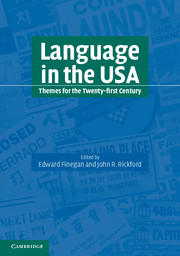Book contents
- Frontmatter
- Contents
- List of figures
- List of tables
- List of contributors
- Acknowledgments
- Foreword
- Editors' preface
- Part 1 American English
- Part 2 Other language varieties
- Part 3 The sociolinguistic situation
- 15 Language ideology and language prejudice
- 16 Ebonics and its controversy
- 17 Language planning, language policy, and the English-Only Movement
- 18 Language in education
- 19 Adolescent language
- 20 Slang
- 21 Hip Hop Nation Language
- 22 Language, gender, and sexuality
- 23 Linguistic identity and community in American literature
- 24 The language of doctors and patients
- 25 The language of cyberspace
- 26 Language attitudes to speech
- Index
19 - Adolescent language
Published online by Cambridge University Press: 05 June 2012
- Frontmatter
- Contents
- List of figures
- List of tables
- List of contributors
- Acknowledgments
- Foreword
- Editors' preface
- Part 1 American English
- Part 2 Other language varieties
- Part 3 The sociolinguistic situation
- 15 Language ideology and language prejudice
- 16 Ebonics and its controversy
- 17 Language planning, language policy, and the English-Only Movement
- 18 Language in education
- 19 Adolescent language
- 20 Slang
- 21 Hip Hop Nation Language
- 22 Language, gender, and sexuality
- 23 Linguistic identity and community in American literature
- 24 The language of doctors and patients
- 25 The language of cyberspace
- 26 Language attitudes to speech
- Index
Summary
Editors' introduction
Adolescence is defined by Webster's Third New International Dictionary as “the period … from puberty to maturity,” and it is, as Penelope Eckert notes, a time in which the construction and marking of identity through style are prominent, particularly in secondary schools. Language is a key resource in the process. Among the features associated with adolescent language in the USA are the use of words like dweeb and hella, the ending of statements with a rising (instead of a falling) intonation, and the use of be like and be all to report interactions (as in he's like (shake head); I'm all – ‘what?!’). Contrary to adult stereotypes and complaints, these adolescent usages are not evidence of inarticulateness or vagueness, Eckert argues. Instead, they are innovations that serve discourse functions and mark identity, just like their adult counterparts such as software or the use of okay with rising intonation (We need to prepare a presentation, okay?).
Moreover, what is striking about adolescent language is not its uniformity and conformity, but its diversity and its connection with ideology, as adolescents choose to adopt or avoid various linguistic resources depending on their ethnicity, gender, orientation to school, and other factors. Eckert discusses several examples, including the use of African American Vernacular English among immigrant adolescents in Northern California who identify with street culture rather than school, and the shunning of double negation by “jocks” in suburban Detroit schools (particularly jock girls), in contrast with its more frequent adoption by “burnouts” (among whom gender differences are less pronounced).
- Type
- Chapter
- Information
- Language in the USAThemes for the Twenty-first Century, pp. 361 - 374Publisher: Cambridge University PressPrint publication year: 2004
- 25
- Cited by

